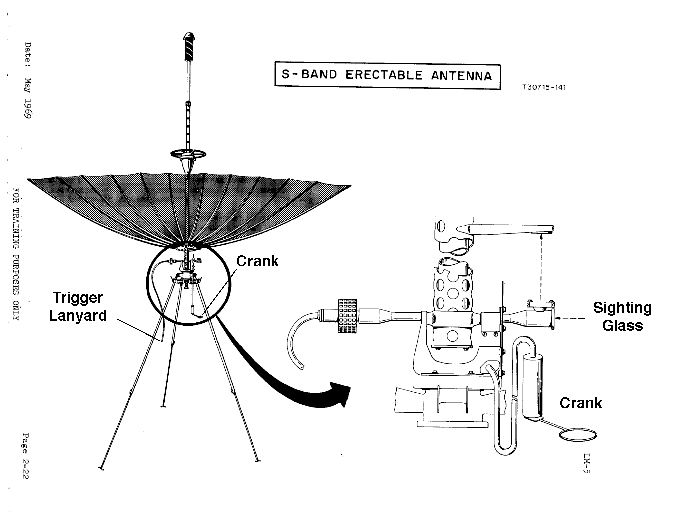
Erectable S-Band Antenna Deployment
| Copyright
© 2010 by the Editors of Working on
the Moon. Some photos taken during an April 1969 training session were published in the 5 May 1969 issue of Aviation Week and Space Technology. Photographer James H. Pickerell has given permission for use of those photos in the Journal. Scans courtesy of Journal Contributor Randy Attwood. Last revised 9 October 2012. |
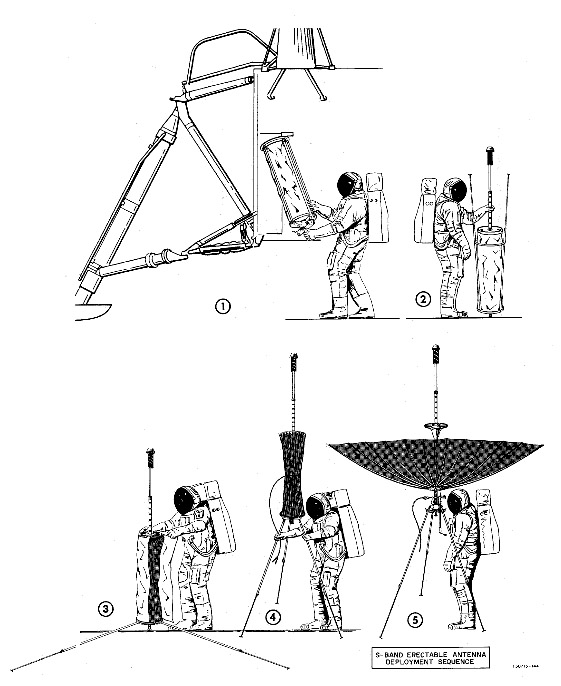
The antenna package, including a thermal/micrometeoroid cover
an end cap and various fastenings, had a terrestial weight of 6.1 kg.
When deployed, the umbrella diameter was 3 m. The tripod height
and base width were both 1.5 meters. Illustrations from pages 2-20 to 2-22
in Lunar Module Structures Handout, LM-5
Summary
The Erectable S-Band Antenna was first flown on Apollo 11 and was intended to provide a stronger television signal. Because time during the brief Apollo 11 EVA was so precious, the expected 19-minute deployment of the antenna would have a major impact of productivity. Consequently, an assessment was made of the first few minutes of the B&W TV signal coming through the LM's steerable antenna. The signal was deemed adequate, so the Erectable S-Band wasn't deployed. It was deployed on both Apollo 12 and 14.
Deployment was intended to be easy enough that one person could do it. However, training convinced the Apollo 12 crew that they might have to work together when aiming the antenna at Earth. On both the Apollo 12 and 14 deployments, the astronauts worked as a team doing rough alignments and then, with one of them watching the sighting glass and making small adjustment to elevation using the flexible-cable crank, the other astronaut held the antenna to keep it relatively steady and to keep it from tipping over. The Apollo 12 and 14 deployments took 15 1/4 and 10 1/2 minutes, respectively. In both instances, the second crewman took part for about 5 minutes.
Detailed procedures can be found on pages 35 to 39 in the Final Apollo 12 Lunar Surface Operations Plan ( 6 Mb ).
Lessons
The low weight and high center-of-mass meant that the antenna was easy to disturb. Evidently, there was enough friction ("stiffness") in the crank mechanism to cause the structure to move or, even, tip over, unless the astronauts worked together to keep it steady while it was being aligned. This is probably a case in which mechanical forces became more important relative to gravity than had been the case on Earth.The Apollo 14 deployment took about 10 minutes 30 seconds versus 15 minutes 15 seconds for Apollo 12. The difference was due entirely to a much quicker alignment, undoubtedly due to lessons learned for the Apollo 12 experience.
Offloading
As indicated, the following two-line decal was in the equipment bay to the right of the ladder, just below the stowed antenna. See Apollo 11 training photo S69-31055.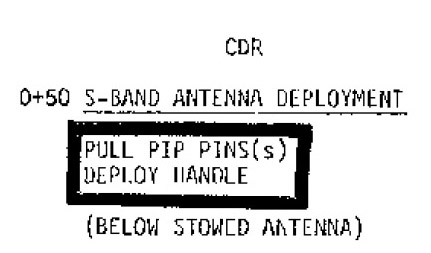
The handle is at the bottom of
the package in the following figure, in the astronaut's
right hand. The astronaut's left hand is on the carry
bar. Click on the image for a larger version.
See, also, a detail
from S69-31056.
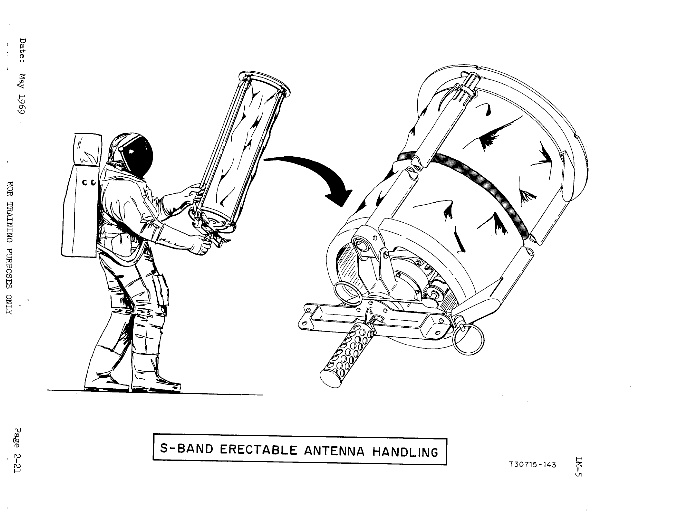
Deployment
The following decal was on the top plate (end cap) of the package as can be seen in a detail from Pickerell photo 01. The plan was to have the deployment in the field-of-view of the 16mm sequence (movie) camera mounted in the LMP's window. 'Gross pointing' may have involved holding the package upright and turning it around its vertical axis until an arrow on the top plate was pointed at Earth's azimuth (training photo S69-31057). The antenna was supported on three telescoping legs, which were to be unlocked at this point (Pickerell photo 02). Finally, the top plate and underlying pad were removed (S69-31150) and discarded (S69-31151).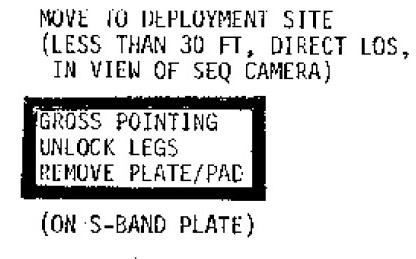
As indicated, the next decal was under the top plate. The antenna's transmitter-receiver was located at the top of a two-section, telescoping mast which, when extended (Pickerell photo 04) and locked, put the transmitter-receiver at the focus of the umbrella-shaped, wire-mesh dish. Once a second azimuthal alignment was done, the three, telescoping legs were extended upward (training photo S69-31058). Then, once a tie-down strap was removed from each leg, they were allowed to rotate down, lying horizontal on the ground but attached at pivot points at the bottom of the main antenna body. At this point, a thermal/micrometeoroid cover (Pickerell photo 05) was removed from from around the bundled umbrella ribs and wire mesh. Finally, the antenna body was lifted vertically (Pickerell photos 06 and 07, and S69-31156) to get the legs into position and locked. (During the Apollo 14 deployment, Alan Shepard removed the thermal cover after the lifted the antenna and got the legs locked.)
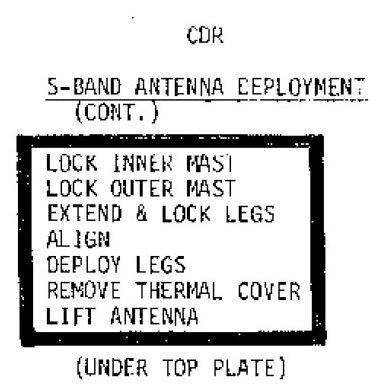
The final deployment decal was on one of the legs. The first steps are to remove the carry bar and a rib protector, as indicated in a labeled detail from training photo S69-31159. Next, a trigger lanyard was released (S69-31160). This put the trigger about halfway down the legs (Pickerell photo 08), which let the astronaut trigger deployment while keeping his helmet and backpack well out of the way of the quite dynamic unfolding (Pickerell photo 09, S69-31162, Apollo 14 training film clip). Finally, the cable connecting the antenna to the LM was extended out from the MESA and mated to the antenna.
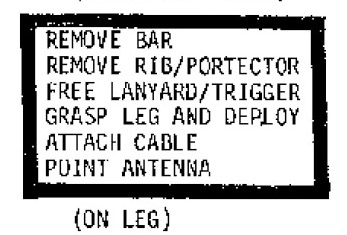
Antenna Alignment
Alignment in both azimuth and elevation (pitch) was done with a flexible-cable crank. Apollo 13 training photo KSC-70PC-0016 shows Jim Lovell using the crank. As detailed on page 38 in the Apollo 12 Lunar Surface Operations Plan, a rough alignment was done first while sighting along the antenna mast (Pickerell photo 12): (e) "Rough align antenna in pitch (CCW rotation of the handle pitches the antenna down). (f) Rough align antenna in azimuth. Pull antenna crank out from housing, then rotate handcrank to change antenna azimuth." Final alignment was done with the aid of a sighting 'glass' mounted on the elevation rotation axis (see the figure below, as well as a detail from training photo S69-17211).(Click on the image for a larger
version.)
Antenna Instability during Alignment
The astronauts found that use of the crank in 1/6th-g disturbed the antenna as a whole and threatened to overturn it. Consequently, one or both of the astonauts had to hold the legs to keep the structure steady. A final problem was keeping the OPS antennas clear of the wire mesh, particuarly when sighting along the mast or using the sighting glass. Detailed commentary on the problems encountered during alignment can be found in the Apollo 12 and 14 Lunar Surface journals starting at 116:01:14 and 114:19:27, respectively.Details of the Apollo 12 and 14 Deployments
For the Apollo 12 deployment, we have only a few seconds of TV relevant to offloading; otherwise, only the audio and transcript. These allow approximate times to be determined for some events. For the Apollo 14 deployment, although the quality of the TV isn't great, we can identify the time of most deployment events from the audio/video record, supplemented by the audio transcript. The Apollo 14 deployment was the shorter of the two by about 5 minutes, due entirely to quicker alignment. Clearly, the Apollo 14 crew learned a great deal from the Apollo 12 experience and, pre-flight, probably worked out an effective way to get the alignment done. Because we have a more complete record of the Apollo 14 deployment, it occurs first in the following table. Crew comments can be found via the links to the relevant portions of the Apollo 12 and Apollo 14 Lunar Surface Journals| Event |
Apollo
14 Ground Elapsed Time (From Television) |
Apollo
14 Time from Start (mm:ss) |
Apollo
12 Ground Elapsed Time (From transcript*) |
Apollo
12
Time from Start (mm:ss) |
Apollo 11 Training
Photographs |
| Total
Task
Times |
|||||
| Start Offload |
114:11:32 |
0 |
115:53:42 | 0 |
|
| Finish Deployment |
114:22:05 | 10:33 |
116:08:59 | 15:15 | |
Deployment details |
|||||
| Start Off-Load | 114:11:32 |
0 |
115:53:42 | 0 |
S69-31055 |
| Carried package away from
bay |
114:12:22 |
00:50 |
115:54:26 |
00:44 |
S69-31056 |
| Reached deployment
location, rough align, remove top plate |
114:13:12 |
01:40 |
115:54:53 |
01:11 |
S69-31057 S69-31150 |
| Discarded top plate |
114:14:04 |
02:32 |
S69-31151 | ||
| Has mast raised |
114:14:34 |
03:02 |
115:56:27 | 02:45 |
S69-31152 |
| Third leg raised |
114:15:06 |
03:34 |
|||
| Leg straps removed, legs
released, tripod raised and legs locked |
114:15:54 |
04:22 |
S69-31155 S69-31156 S69-31157 S69-31158 |
||
| Umbrella cover removed
and discarded |
114:16:01 |
04:29 |
115:58:11 | 04:29 |
S69-31159 Cover is in the foreground in this A11 training photo, with the carry bar on top of it. |
| Question from Houston
about leg penetration answered |
114:16:26 |
04:54 |
|||
| Removed and discarded
carry bar and rib protector |
114:16:51 |
05:19 |
115:59:25 |
05:43 |
S69-31159(detail) S69-31165(detail) Neil has the rib protector in his right hand and will let it slide down the leg on our right. |
| 2nd leg question answered |
114:17:01 |
05:29 |
|||
| Al worked on far side of
the antenna, probably deploying the trigger
lanyard. Ed brought the connecting cable from the
MESA. Noticed that the antenna was too far from
the MESA. |
114:17:27 |
05:55 |
S69-31160 S69-31161 |
||
| Ed returned to MESA to
see if he has pulled the full cable length out.
Returned. |
114:18:04 |
06:32 |
|||
| Antenna in final location |
114:18:33 |
07:01 |
|||
| Umbrella released but
hung up; antenna tipped 90 degrees so Mitchell could
free. Returned to upright. |
114:19:27 |
07:55 |
116:01:14 Didn't get hung up. |
07:32 |
S69-31162 S69-31163 Apollo 14 training film clip Didn't get hung up. |
| Shepard used the crank to
set approximate elevation. |
114:20:42 |
09:10 |
S69-31059(detail) S69-311179 KSC-70PC-0016 (Apollo 13 training photo showing Jim Lovell using the crank) |
||
| Mitchell on the sighting
"glass". Shepard adjusted azimuth, looking from
behind. They then fine-tuned elevation and got Earth
centered. |
114:22:05 |
10:33 |
116:08:59 |
00:00 |
S69-17211(detail) S69-31165 S69-31165(detail) unnumbered training photo |
* Times inferred from the Apollo 12 transcript are more uncertain than those from the audio-synched Apollo 14 TV record.
Return to Table of Contents
